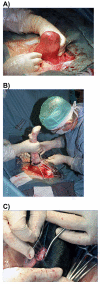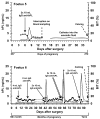Effect of exogenous circulating anti-bPL antibodies on bovine placental lactogen measurements in foetal samples
- PMID: 20128904
- PMCID: PMC2831016
- DOI: 10.1186/1751-0147-52-9
Effect of exogenous circulating anti-bPL antibodies on bovine placental lactogen measurements in foetal samples
Abstract
Background: The involvement of placental lactogen (PL) in the regulation of foetal growth has been investigated in different species by in vivo immunomodulation techniques. However, when circulating antibodies are present together with the hormone, the procedure for hormonal measurement becomes considerably complex. The aim of this study was the immunoneutralization of bovine placental lactogen (bPL) concentrations in bovine foetal circulation by direct infusion of rabbit anti-bPL purified immunoglobulins (IgG) via a foetal catheter (in vivo study). The ability of a RIA based on guinea pig anti-bPL antiserum, for the measurement of bPL concentrations in samples containing exogenous rabbit anti-bPL immunoglobulins, was also analyzed in in vitro and in vivo conditions.
Methods: Six bovine foetuses were chronic cannulated on the aorta via the medial tarsal artery. Infusion of rabbit anti-bPL IgG was performed during late gestation. Pooled rabbit anti-bPL antisera had a maximal neutralization capacity of 25 microg bPL/mL of immunoglobulin. Interference of rabbit anti-bPL immunoglobulin with radioimmunoassay measurement using guinea pig anti-bPL as primary antibody was first evaluated in vitro. Polyclonal anti-bPL antibodies raised in rabbit were added in foetal sera to produce 100 samples with known antibodies titers (dilutions ranging from 1:2,500 till 1:1,280,000).
Result(s): Assessment of the interference of rabbit anti-bPL antibody showed that bPL concentrations were significantly lower (P < 0.05) in samples added with dilutions of rabbit antiserum lower than 1:80,000 (one foetus) or 1:10,000 (four foetuses). It was also shown that the recovery of added bPL (12 ng/mL) was markedly reduced in those samples in which exogenous rabbit anti-bPL were added at dilutions lower than 1:20,000. Concentrations of foetal bPL were determined in samples from cannulated foetuses. In foetuses 1 and 6, bPL concentrations remained almost unchanged (<5 ng/mL) during the whole experimental period. In Foetus 3, bPL concentrations decreased immediately after IgG infusion and thereafter, they increased until parturition.
Conclusion(s): The use of a bPL RIA using a guinea pig anti-bPL as primary antiserum allowed for the measurement of bPL concentrations in foetal plasma in presence of rabbit anti-bPL IgG into the foetal circulation. Long-term foetal catheterization allowed for the study of the influence of direct infusion of anti-bPL IgG on peripheral bPL concentrations in bovine foetuses.
Figures



Similar articles
-
Radioimmunoassay of bovine placental lactogen using recombinant and native preparations: determination of fetal concentrations across gestation.Reprod Fertil Dev. 2007;19(7):877-85. doi: 10.1071/rd06173. Reprod Fertil Dev. 2007. PMID: 17897591
-
Expression profile and protein levels of placental products as indirect measures of placental function in in vitro-derived bovine pregnancies.Reproduction. 2006 Jan;131(1):163-73. doi: 10.1530/rep.1.00739. Reproduction. 2006. PMID: 16388019
-
Altered placental lactogen and leptin expression in placentomes from bovine nuclear transfer pregnancies.Biol Reprod. 2004 Dec;71(6):1862-9. doi: 10.1095/biolreprod.104.032201. Epub 2004 Aug 11. Biol Reprod. 2004. PMID: 15306554
-
Native and recombinant bovine placental lactogens.Reprod Biol. 2008 Jul;8(2):85-106. doi: 10.1016/s1642-431x(12)60006-0. Reprod Biol. 2008. PMID: 18677398 Review.
-
Variation among species in the endocrine control of mammary growth and function: the roles of prolactin, growth hormone, and placental lactogen.J Dairy Sci. 1986 Mar;69(3):886-903. doi: 10.3168/jds.S0022-0302(86)80479-9. J Dairy Sci. 1986. PMID: 3519707 Review.
References
-
- Goffin V, Shiverick KT, Kelly PA, Martial JA. Sequence-function relationships within the expanding family of prolactin, growth hormone, placental lactogen, and related proteins in mammals. Endocr Rev. 1996;17:385–410. - PubMed
-
- Breier BH, Funk B, Surus A, Ambler GR, Wells CA, Waters MJ, Gluckman PD. Characterization of ovine growth hormone (oGH) and ovine placental lactogen (oPL) binding to fetal and adult hepatic tissue in sheep: evidence that oGH and oPL interact with a common receptor. Endocrinology. 1994;135:919–928. doi: 10.1210/en.135.3.919. - DOI - PubMed
Publication types
MeSH terms
Substances
LinkOut - more resources
Full Text Sources

